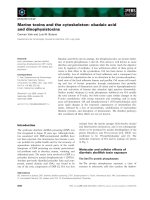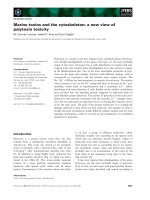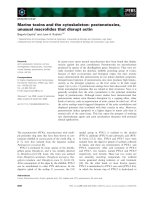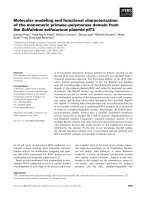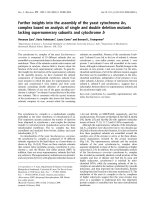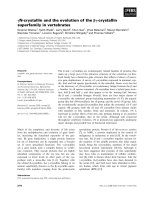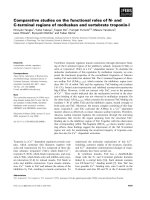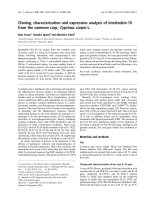Báo cáo khoa học: "User studies and the design of Natural Language Systems" doc
Bạn đang xem bản rút gọn của tài liệu. Xem và tải ngay bản đầy đủ của tài liệu tại đây (762.58 KB, 8 trang )
User studies and the design of Natural Language Systems
Steve Whittaker and Phil Stenton
Hewlett-Packard Laboratories
Filton Road, Bristol BS12 6QZ, UK.
email: sjw~hplb.hpl.hp.com
Abstract
This paper presents a critical discussion of the vari-
ous approaches that have been used in the evaluation
of Natural Language systems. We conclude that pre-
vious approaches have neglected to evaluate systems
in the context of their use, e.g. solving a task requir-
ing data retrieval. This raises questions about the
validity of such approaches. In the second half of the
paper, we report a laboratory study using the Wizard
of Oz technique to identify NL requirements for carry-
ing out this task. We evaluate the demands that task
dialogues collected using this technique, place upon
a prototype Natural Language system. We identify
three important requirements which arose from the
task that we gave our subjects: operators specific to
the task of database access, complex contextual refer-
ence and reference to the structure of the information
source. We discuss how these might be satisfied by
future Natural Language systems.
1 Introduction
1.1
Approaches to the evaluation of
NL systems
It is clear that a number of different criteria might
be employed in the evaluation of Natural Language
(NL) systems. It is also clear that there is no
consensus on how evaluation should be carried out
[RQR*88, GM84]. Among the different criteria that
have been suggested are (a) Coverage; (b) Learnabil-
ity; (c) General software requirements; (d) Compar-
ison with other interface media. Coverage is con-
cerned with the set of inputs which the system should
be capable of handling and one issue we will discuss
is how this set should be identified. Learnability is
premised on the fact that complete coverage is not
forseeable in the near future. As a consequence, any
NL system will have limitations and one problem for
users will be to learn to communicate within such
limitations. Learnability is measured by the ease
with which new users are able to identify these cov-
erage limitations, and exploit what coverage is avail-
able to carry out their task. The general software
criteria of importance are speed, size, modifiabil-
ity and installation and maintenance costs. Com-
parison studies have mainly required users to per-
form the same task using either a formal query lan-
guage such as SQL or a restricted natural language
and evaluated one against the other on such param-
eters as time to solution or number of queries per
task[SW83, JTS*85]. Our discussion will mainly ad-
dress the problem of coverage: we shall not discuss
these other issues further.
Our concern here will be with interactive NL in-
terfaces and not other applications of NL technology
such as MT or messaging systems. Interactive inter-
faces are not designed to be used in isolation, rather,
they are intended to be connected to some sort of
backend system, to improve access to that system.
Our view is that NL systems should be evaluated with
this in mind: the aim will be to identify the NL in-
puts which a typical user would want to enter
in order to utillse that backend system to carry
out
a representative task. By representative task
we mean the class of task that the back-end system
was designed to carry out. In the case of databases,
this would be accessing or updating information. For
expert systems it might involve identifying or diag-
nosing faults. °
I.I.I Test suites
One method that is often used in computer science for
the evaluation of systems is the use of test suites. For
NL systems the idea is to generate a corpus of sen-
tences which contains the major set of syntactic, se-
- 116-
mantic and pragmatic phenomena the system should
cover [BB84, FNSW87]. One problem with this ap-
proach is how we determine whether the test set is
complete. Do we have a clear notion of what consti-
tute the major phenomena of language so that we can
generate test sentences which identify whether these
have been analysed correctly? Theories of syntax are
well developed and may provide us with a good tax-
onomy of syntactic phenomena, but we do not have
similar classifications of key pragmatic requirements.
There are two reasons why current approaches may
fail to identify the key phenomena. Current test sets
are organised on a single-utterance basis, with certain
exceptions such as intersentential anaphora and ellip-
sis. Now it may be that more complex discourse phe-
nomena such as reference to dialogue structure arise
when systems are being used to carry out tasks, be-
cause of the need to construct and manipulate sets of
information [McK84]. In addition, context may con-
tribute to inputs being fragmentary or telegraphic
in style. Unless we investigate systems being used
to carry out tasks, such phenomena will continue to
he omitted from our test suites and NL systems will
have to be substantially modified when they are con-
nected to their backend systems. Thus we are not
arguing against the use of test suites in principle but
rather are attempting to determine what methodol-
ogy should be used to design such test suites.
1.1.2 Field studies
In field studies, subjects are given the NL inter-
face connected to some application and encouraged
to make use of it. It would seem that these stud-
ies would offer vital information about target re-
quirements. Despite arguments that such studies are
highly necessary [Ten79], few systematic studies have
been conducted [Dam81, JTS*85, Kra80]. The prob-
lem here may be with finding committed users who
are prepared to make serious use of a fragile system.
A major problem with such studies concerns the
robustness of the systems which were tested and this
leads to difficulties in the interpretation of the results.
This is because a fragile system necessarily imposes
limitations on the ways that a user can interact with
it. We cannot therefore infer that the set of sentences
that users input when they have adjusted to a frag-
ile system, reflects the set of inputs that they would
wish to enter given a system with fewer limitations.
In other words we cannot infer that such inputs repre-
sent the way that users would ideally wish to interact
using NL. The users may well have been employing
strategies to communicate within the limitations of
the system and they may therefore have been using
a highly restricted form of English. Indeed the exis-
tence of strategies such as paraphrasing and syntax
simplification when a query failed, and repetition of
input syntax when a query succeeded has been doc-
umented [ThoS0, WW89].
Since we cannot
currently
envisage a system with-
out limitations, we may want to exploit this ability to
learn system limitations, nevertheless the existence of
such user strategies does not give us a clear view of
what language might have been used in the absence
of these limitations.
1.1.3 Pen and paper tasks
One technique which overcomes some of the prob-
lems of robustness has been to use pen and paper
tasks. Here we do not use a system at all but rather
give subjects what is essentially a translation task
[JTS*85, Mil81]. This technique has also been em-
ployed to evaluate formal query languages such as
SQL. The subjects of the study are given a sample
task:
A list of alumni in the state of California has
been requested. The request applies to those alumni
whose last name starts with an S. Obtain such a list
containing last names and first names.
When the
subjects have generated their natural language query,
it is evaluated by judges to determine whether it
would have successfully elicited the information from
the system.
This approach avoids the problem of using fragile
systems, but it is susceptible to the same objections
as were levelled at test suites: a potential drawback
with the approach concerns the representativeness of
the set of tasks the users are required to do when
they carry out the translation tasks. For the tasks
described by Reisner, for example, the queries are all
one shot, i.e. they are attempts to complete a task
in a single query [Rei77]. As a result the translation
problems may fail to test the system's coverage of
discourse phenomena.
1.1.4 Wizard of Oz
A
similar technique to pen and paper tasks has been
the use of a method called the "Wizard of Or" (hence-
forth WOZ) which also avoids the problem of the
fragility of current systems by simulating the opera-
tion of the system rather than using the system itself.
- 117-
In these studies, subjects are told that they are in-
teracting with the computer when in reality they are
linked to the Wizard, a person simulating the opera-
tion of the system, over a computer network.
In Guindon's study using the WOZ technique,
subjects were told they were using an NL front-
end to a knowledge-based statistics advisory package
[GSBC86]. The main result is a counterintuitive one.
These studies suggest that people produce "simple
language" when they believe that they are using an
NL interface. Guindon has compared the WOZ dia-
logues of users interacting with the statistics package,
to informal speech, and likened them to the simplified
register of "baby talk" [SF7?]. In comparison with
informal speech, the dialogues have few passives, few
pronouns and few examples of fragmentary speech.
One problem with the research is that it has
been descriptive: It has chiefly been concerned with
demonstrating the fact that the language observed
is "simple" relative to norms gathered for informal
and written speech and the results are expressed at
too general a level to be useful for system design.
It is not enough to know, for example, that there
are fewer fragments observed in WOZ type dialogues
than in informal speech: it is necessary to know the
precise characteristics of such fragments if we are to
design a system to analyse these when they occur.
Despite this, our view is that WOZ represents the
most promising technique for identifying the target
requirements of an NL interface. However, to avoid
the problem of precision described above, we modified
the technique in one significant respect. Having used
the WOZ technique to generate a set of sentences that
users ideally require to carry out a database retrieval
task, we then input these sentences into a NL system
linked to the database. The target requirements are
therefore evaluated against a version of a real system
and we can observe the ways in which the system
satisfies, or fails to satisfy, user requirements.
We discuss semantics and pragmatics only insofar as
they are reflected in individual lexical items. This
is of some importance, given the lexical basis of the
HPNL system. It must also be noted that the evalua-
tion took place against a prototype version of HPNL.
Many of the lexical errors we encountered could be
removed with a trivial amount of effort. Our inter-
est was not therefore in the absolute number of such
errors, but rather with the general classes of lexical
errors which arose. We present a classification of such
errors below.
The task we investigated was database retrieval.
This was predominantly because this has been a typ-
ical application for NL interfaces. Our initial inter-
est was in the target requirements for an NL system,
i.e. what set of sentences users would enter if they
were given no constraints on the types of sentences
that they could input. The Wizard was therefore in-
structed to answer all questions (subject to the limi-
tation given below). We ensured that this person had
sufficient information to answer questions about the
database, and so in principle, the system was capable
of handling all inputs.
The subjects were asked to access information from
the "database" about a set of paintings which pos-
sessed certain characteristics. The database con-
tained information about Van Gogh's paintings in-
cluding their age, theme, medium, and location. The
subjects had to find a set of paintings which together
satisfied a series of requirements, and they did this
by typing English sentences into the machine. They
were not told exactly what information the database
contained, nor about the set of inputs the Natural
Language interface might be capable of processing.
2 Method
1.2 The current study
The
current study therefore has two components: the
first is a WOZ study of dialogues involved in database
retrieval tasks. We then take the recorded dialogues
and map them onto the capabilities of an existing
system, HPNL [NP88] to look at where the language
that the users produce goes beyond the capabilities
of this system. The results we present concern the
first phase of such an analysis in which we discuss
the set of words that the system failed to analyse.
2.1 Subjects
The 12 subjects were all familiar with using com-
puters insofar as they had used word processors and
electronic mail. A further 5 of them had used omce
applications such as spreadsheets or graphics pack-
ages. Of the remainder, 4 had some experience with
using databases and one of these had participated in
the design a database. None of them was familiar
with the current state of NL technology.
- 118-
2.2 Procedure
hard copy.
The experimenter told the subjects that he was in-
terested in evaluating the efficiency of English as a
medium for communicating with computers. He told
them that an English interface to a database was run-
ning on the machine and that the database contained
information about paintings by Van Gogh and other
artists. In fact this was not true: the information that
the subjects typed into the terminal was transmitted
to a person (The Wizard) at another terminal who
answered the subject's requests by consulting paper
copies of the database tables.
The experimenter then gave the details of the two
tasks. Subjects were told that they had to find a set of
paintings which satisfied several requirements, where
a requirement might be for example that (a) all the
paintings must come from different cities; or (b) they
must all have different themes. Having found this set,
they had then to access particular information about
the set of pictures that they had chosen, e.g the paint
medium for each of the pictures chosen.
3 Results
3.1 Preliminary analysis and filtering
This analysis is concerned with user input and so the
Wizard's responses are not considered here. We be-
gan by taking all the 384 subject utterances, entering
them into the NL prototype and observing what anal-
ysis the system produced. We found that by far the
largest category of errors was unknown words, so we
began by analysing the total of 401 instances of 104
unknown words.
Our interest here lay in the influence of the task
on language use so we focus on 3 classes of unknown
words which demonstrate this in different ways: these
were operators and explicit reference to set proper-
ties; references to context; and references to the in-
formation source.
Our interest was in the target set of queries input
by people who wanted to use the system for database
access. We therefore gave the Wizard instructions to
answer all queries regardless of linguistic complexity.
There was however one exception to this rule: each
task was expressed as a series of requirements and one
possible strategy for the task was to enter all these
requirements as one long query. If the Wizard had an-
swered this query then the dialogue would have been
extremely short, i.e it would have been one query and
a response which was the answer to the whole task.
To prevent this, the .Wizard was told to reply to such
long queries by saying Too much information to pro-
cess. There were no other constraints on the type
of input that the Wizard could process and answers
were given to all other types of query.
Subject and Wizard both used HP-Unix Worksta-
tions and communicated by writing in networked X
windows. The inputs of both subject and Wizard
were displayed in a single window on each of the ma-
chines with the subject's entries presented in lower
case and the Wizard's in upper case, so the con-
tents
of the
display windows on both machines were
identical. To avoid teaching the subjects skills like
scrolling, we also provided them with hard copy out-
put of the whole of the interaction by printing the
contents of the windows to a printer next to the sub-
jeet's machine. If they wanted to refer back to much
earlier in the dialogue, the
subjects could consult the
3.1.1 Operators and the explicit specification
of set properties
The task of database access involves the construction
and manipulation of answer sets with various prop-
erties.
The unknown words that were used for set con-
struction and manipulation were mainly verbs. These
we called operators. They can be further subclassi-
fled into verbs which were used to select sets, those
which were used to permute already constructed
sets and those which operate over a set of queries.
The majority of operators invoked simple set selec-
tion: these included for example, state and tell. There
were also instances of indirect requests for selection,
e.g. need and want. Subjects tried to permute the
presentation of sets by using words like arrange. Fi-
nally queries such as All the conditions from now on
will apply to show there were verbs which oper-
ated over sets of queries.
A second way in which these set manipulation op-
erations appeared was in the subjects' explicit ref-
erence to the fact that they were constructing sets
with specific properties. Find paintings that satisfy
the following
criteria
was an example of this.
Altogether operators and explicit reference to
set
- 119-
properties occurred on 102 occasions which accounted
for 25% of the unknown words.
3.1.2 References to context
The task could not be accomplished in one query so
we expected that this would necessitate our subjects
making reference to previous queries. We therefore
went on to analyse those unknown words that re-
quired information from outside the current query
for their interpretation. Among the unknown words
which relied upon context, we distinguished between
what we called pointers (N = 42 instances) and ex-
clusion operators (N = 21 instances). Together
they accounted for 16% of unknown words.
Pointers signalled to the listener that the reference
set lay outside the current utterance. These could be
further subdivided according to whether or not they
pointed forwards, e.g.
Give me the dates of the
fol-
lowing
paintings
or backwards in the dialogue,
e.g.
previous
and
above.
There were two instances of
forwards pointers
following
and
now on.
The backwards pointers could be subclassified ac-
cording to how many previous answer sets they re-
ferred to. The majority referred to a single answer
set and this was most often the one generated by the
immediately prior query. Other pointers referred to
a number of prior answer sets, which could scope as
far back as the beginning of the current subdialogue,
or even the beginning of the whole dialogue.
Exclusion operators applied to sets created ear-
lier in the dialogue. They served to exclude elements
of these sets from the current query. The simplest ex-
amples of this occurred when people had (a) identified
a set previously; (b) they had then selected a subset
of this original set; and (c) they wanted all or part of
the set of the original set which had not been selected
by the second opergtion. These included words like
another
and
more, as
in
Give me I0
more
Van Gogh
paintings.
A more complex instance of this type of exclusion
was when the word was used, not to exclude sub-
sets from sets already identified, but to exclude the
attributes of the items in the excluded subsets, e.g.
Find me a painting with a theme that is
different
from those already mentioned.
Here the system has
first to generate the set of paintings already men-
tioned, then it has to generate their themes and then
finally it has to find a painting whose theme is differ-
ent from the set of themes already identified.
3.1.3 References to the information source
Our subjects believed that they were interacting with
a real information source, in this case a database, also
seemed to affect their language use. We found 19 (5%
of all unknown words) which seemed to refer to the
database and its structure directly.
There were words which seemed to refer to field
names in the database, e.g.
categories
and
infor-
mation,
e.g.
What
information
on each painting is
there?
There were also words which seemed to refer
to values within a field, e.g.
types as
in
List the me-
dia
types. In addition, there were references to the
ordering of entities, e.g.
first
or
second, as
in
What
is the
first
painting in your list?.
Finally, there were
words which referred to the general scope or prop-
erties of the database: e.g.
database
and
represented,
e.g.
What different paint media are
represented?.
There were also 3 occasions on which reference
is made both to database structure and to context.
These are the instances of
next
being used to access
entities in a column but also referring to context. The
utterance
List
next
10 paintings,
references 10 items
in the sequence that they appear in the database,
but excludes the 10 items already chosen. Finally
there was one instance of a question which would
have required inferencing based on the structure of
the information source,
Is a portrait the
same
as a
self portrait?.
Here the question was about the type
relation.
4 Conclusions
This paper had two objectives: the first was to eval-
uate the use of the WOZ technique for assessing NL
systems and the second was to investigate the effect
of task on language use.
One criticism we made of both test suites and tasks
using pen and paper, was that they may attempt to
evaluate systems against inadequate criteria. Specif-
ically they may not evaluate the adequacy of NL sys-
tems when users are carrying out tasks with specific
software systems. The unknown words analysis seems
to bear this out: we found 3 classes of unknown words
which occurred only because our users were doing a
task. Firstly our users wanted to carry out operations
- 120 -
involving the selection and permutation of answer
sets and make explicit reference to their properties.
Secondly, we found that our subjects wanted to use
complex reference to refer back to previous queries in
order to refine those queries, or to exclude answers
to previous queries from their current query. Finally,
we found that users attempted to use the structure of
the information source, in this case the database, in
order to access information. Together these 3 classes
accounted for 45% of all unknown words. We be-
lieve that whatever the task and software, there will
always be instances of operators, context use and ref-
erence to the information source. It would therefore
seem that coverage of these 3 sets of phenomena is an
important requirement for any NL interface to an ap-
plication. The fact that other evaluation techniques
may not have detected this requirement is, we be-
lieve, a vindication of our approach. An exception to
this is the work of Cohen et al. [CPA82] who point
to the need for retaining and tracking context in this
type of application.
Of course there are still problems with the WOZ
technique. One such problem concerns the task rep-
resentativeness and a difficulty in designing this study
lay in the selection of a task which we felt to be typi-
cal of database access. Clearly more information from
field studies would be useful in helping to identify
prototypical database access tasks.
A second problem lies in the interpretation of the
results with respect to the classification and fre-
quency of the unknown word errors: how frequently
must an error occur if it is to warrant system modi-
fication? For example, references to the information
source accounted for only 5% of the errors and yet
we believe this is an interesting class of error because
exploiting the structure of the database was a useful
retrieval tactic for some users. The frequency prob-
lem is not specific to this study, but is an instance of
a general problem in computational linguistics con-
cerning the coverage and the range of phenomena to
which we address our research. In the past, the field
has focussed on the explanation of theoretically inter-
esting phenomena without much attention to their
frequency in naturally occurring speech or text. It
is
clear, however, that if we are to be successful in
designing working systems, then we cannot afford to
ignore frequently occurring but theoretically uninter-
esting phenomena such as punctuation or dates. This
is because such phenomena will probably have to be
treated in whatever application we design. Frequency
data may also be of real use in determining priorities
for system improvement.
As a result of using our technique, we have iden-
tified a number of unknown words. How should
these words be treated? Some of the unknown words
are synonyms of words already in the system. Here
the obvious strategy is to modify the NL system by
adding these. In other cases, system modification
may not be possible because linguistic theory does
not have a treatment of these words.h In these cir-
cumstances, there are three possible strategies for fi-
nessing the problem. The first two involve encour-
aging users to avoid these words, either by gener-
ating co-operative error messages to enable the user
to rephrase the query and so avoid the use of the
problematic word [Adg88, Ste88] or by user training.
The third strategy for finessing the analysis of such
words is to supplement the NL interface with another
medium such as graphics, and we will describe an ex-
ample of this below.
We believe that the use of such finessing strategies
will be important if NL systems are to be usable in
the short term. Our data suggests that certain words
are used frequently by subjects in doing this task.
It is also clear that computational linguistics has no
treatment of these words. If we wish to build a system
which will enable our users to carry out the task, we
must be able to respond in some way to such inputs.
The above techniques may provide the means to do
this, although the use of such strategies is still an
under-researched area.
For the unknown words encountered in this study,
of the operators, many can be dealt with by sim-
ple system modification because they are synonyms
of
list
or
show.
Within the class of operators, how-
ever, it would seem that new semantic interpretation
procedures would have to be defined for verbs like ar-
range
or
order.
These would involve two operations,
the first would be the generation of a set, and the sec-
ond the sorting of that set in terms of some attribute
such as age or date. The unknown words relating to
explicit reference to set properties would not be dif-
ficult to add to the system, given that they can be
paraphrased as relative clauses. For example, the sen-
tence
Find Van Gogh paintings to
include
four dif-
ferent themes
can be paraphrased as
Find Van Gogh
paintings that have different themes.
The context words present a much more serious
problem. Current linguistic theory does not have
treatments of words like
previously
or
already,
in
terms of how these scope in dialogues. On some oc-
casions, these are used to refer to the immediately
prior query only, whereas on other occasions they
- 121 -
might scope back to the beginning of the dialogue.
In addition, words like
more
or
another
present new
problems for discourse theory in that they require ex-
tensional representations of answers: Given the query
Give me 10 paintingsfollowedby Now give me 5 more
paintings,
the system has to retain an extensional rep-
resentation of the answer set generated to the first
query, if it is to respond appropriately to the second
one. Otherwise it will not have a record of precisely
which 10 paintings were originally selected, so that
these can be excluded from the second set. This ex-
tensional record would have to be incorporated into
the discourse model.
One solution to the dual problems presented by
context words is again to either finesse the use of such
words or to use a mixed media interface of NL and
graphics. If users had the answers to previous queries
presented on screen, then the problems of determin-
ing the reference set for phrases like
the paintings al.
ready mentioned
could be solved by allowing the users
to click on previous answer sets using a mouse, thus
avoiding the need for reference resolution.
For
the references to the information source,
it would not be difficult to modify the system so
it could analyse the majority of the the specific in-
stances recorded here, but it is not clear that all of
them could have been solved in this way, especially
those that require some form of inferencing based on
the database structure.
There are also a number of unknown words in the
data that have not been discussed here, because these
did not directly arise from the fact that our users were
carrying out a task. Nevertheless, the set of strate-
gies given above is also relevant to these. Just as
with the task specific words, there are a number of
words which can be added to the system with rel-
atively little effort. The system can be modified to
cope with the majority of the open class unknown
words, e.g. common nouns, adjectives, and verbs,
many of which are simple omissions from the domain-
specific lexicon. Some of the closed class words such
as prepositions and personal pronouns may also prove
straightforward to add.
There are
also
a number of these words which did
not arise from the task, which are more difficult to
add to the system. This is true for a few the open
class words domain-independent words, including ad-
jectives like
same
and
different.
The majority of the
closed class words, may also be difficult to add to
the system, including superlatives and various logi-
cal connectives,
then, neither,
some quantifiers, e.g.
only, as
well as words which relate to the control of
dialogue such as
right
and
o.k
These words indi-
cate genuine gaps in the coverage of the system. For
these difficult words, it might necessary to finesse the
problem of direct analysis.
In conclusion, the WOZ technique proved success-
ful for NL evaluation. We identified 3 classes of
task based language use which have been neglected
by other evaluation methodologies. We believe that
these classes exist across applications and tasks: For
any combination of application and task, specific op-
erators will emerge, and support will have to be pro-
vided to enable reference to context and information
structure. In addition, we were able to suggest a num-
ber of strategies for dealing with unknown words. For
certain words, NL system modification can be easily
achieved. For others, different strategies have to be
employed which avoid direct analysis of these words.
These finessing strategies are important if NL sys-
tems are to usable in the short term.
5 Acknowledgements
Thanks to Lyn Walker, Derek Proudian, and David
Adger for critical comments.
References
[AdgS8]
[BB84]
[CPA82]
[Dam81]
David Adger.
Heuristic input redaction.
Technical Report, Hewlett-Packard Lab-
oratories, Bristol, 1988.
Madeleine Bates and Robert J. Bobrow.
What's here, what's coming, and who
needs it. In Walter Reitman, editor, Ar-
tificial Intelligence Applications for Busi-
ness,
pages 179-194, Ablex Publishing
Corp, Norwood, N.J., 1984.
Phillip R. Cohen, C. Raymond Perrault,
and James F. Allen. Beyond question
answering. In Wendy Lehnert and Mar-
tin Ringle, editors,
Strategies for
Natu-
ral Language Processing,
pages 245-274,
Lawrence Erlbaum Ass. Inc, Hillsdale,
N.J.,
1982.
Fred J. Damerau. Operating statistics for
the transformational question answering
system.
American Journal of Computa-
tional Linguistics,
7:30-42, 1981.
- 122 -
[FNSW87]
[CM84]
[aSBC86]
[JTS*85]
[Kra80]
[McK84]
[MilS1]
[NP88]
[Rei77]
[RQR*88]
Daniel Fliekinger, John Nerbonne, Ivan
Sag, and Thomas Wasow. Towards eval-
uation of nip systems. 1987. Presented
to the 25th Annual Meeting of the Asso-
ciation for Computational Linguistics.
G. Guida and G. Mauri. A formal ba-
sis for performance evaluation of natural
language understanding systems.
Amer-
ican Journal of Computational Linguis-
tics,
10:15-29, 1984.
Raymonde Guindon, P. Sladky, H. Brun-
ner, and J. Conner. The structure of
user-adviser dialogues: is there method
in their madness? In
Proc. 24st An-
nual Meeting of the ACL, Association
of Computational Linguistics,
pages 224-
230, 1986.
Matthias Jarke, Jon A. Turner, Ed-
ward A. Stohr, Yannis Vassiliou, Nor-
man H. White, and Ken Michielsen. A
field evaluation of natural language for
data retrieval.
IEEE Transactions on
Software Engineering,
SE-11, No.1:97-
113, 1985.
Jurgen Kranse. Natural language access
to information systems: an evaluation
study of its acceptance by end users.
In-
formation Systems,
5:297-318, 1980.
Kathleen R. MeKeown. Natural language
for expert systems: comparisons with
database systems. In
COLING84: Proc.
lOth International Conference on Compu-
tational Linguistics. Stanford University,
Stanford, Ca.,
pages 190-193, 1984.
L. A. Miller. Natural language program-
ming: styles, strategies and contrasts.
IBM Systems Journal,
20:184- 215, 1981.
John Nerbonne and Derek Proudian.
The
HPNL System Report.
Technical Re-
port STL-88-11, Hewlett-Packard Labo-
ratories, Palo Alto, 1988.
Phyllis Reisner. Use of psychological ex-
perimentation as an aid to development
of a query language.
IEEE Transactions
on Software Engineering,
SE-3, No.3:219-
229, 1977.
W. Read, A. Quiliei, J. Reeves, M. Dyer,
and E. Baker. Evaluating natural lan-
guage systems: a sourcebook approach.
[SF77]
[Ste88]
[sw83]
[Ten79]
[Tho80]
[ww891
In
COLING88: Proc. l~th International
Conference on Computational Linguis-
tics,
Budapest, Hungary, 1988.
C. Snow and C. A. Ferguson.
Talking
to children.
Cambridge University Press,
1977.
Phil Stenton.
Natural Language: a
snapshot taken from ISC January 1988.
Technical Report HPL-BRC-TR-88-022,
Hewlett-Packard Laboratories, Bristol,
U.K., 1988.
Duane W. Small and Linda J. Weldon.
An experimental comparison of natural
and structured query languages.
Human
Factors,
25(3):253-263, 1983.
Harry R. Tennant.
Evaluation of Natural
Language Processors.
PhD thesis, Uni-
versity of Illinois Urbana, 1979.
Bozena Henisz Thompson. Linguis-
tic analysis of natural language com-
munication with computers. In
COL-
ING80: Proc. 8th International Con-
ference on Computational Linguistics.
Tokyo,
pages 190-201, 1980.
Marilyn Walker and Steve Whittaker.
When Natural Language is Better than
Menus: A Field Study.
Technical Re-
port, Hewlett Packard Laboratories, Bris-
tol, England, 1989.
- 123-

